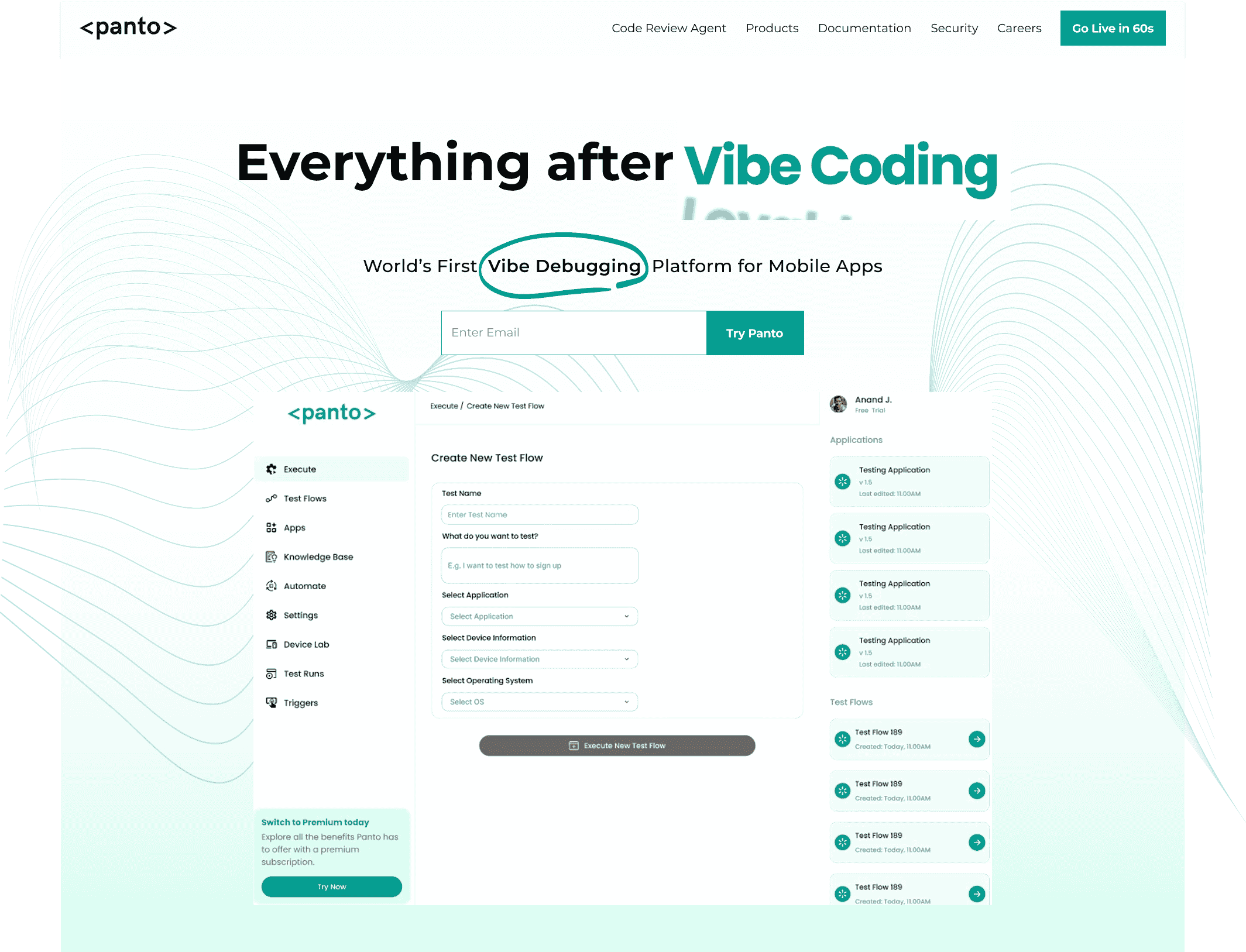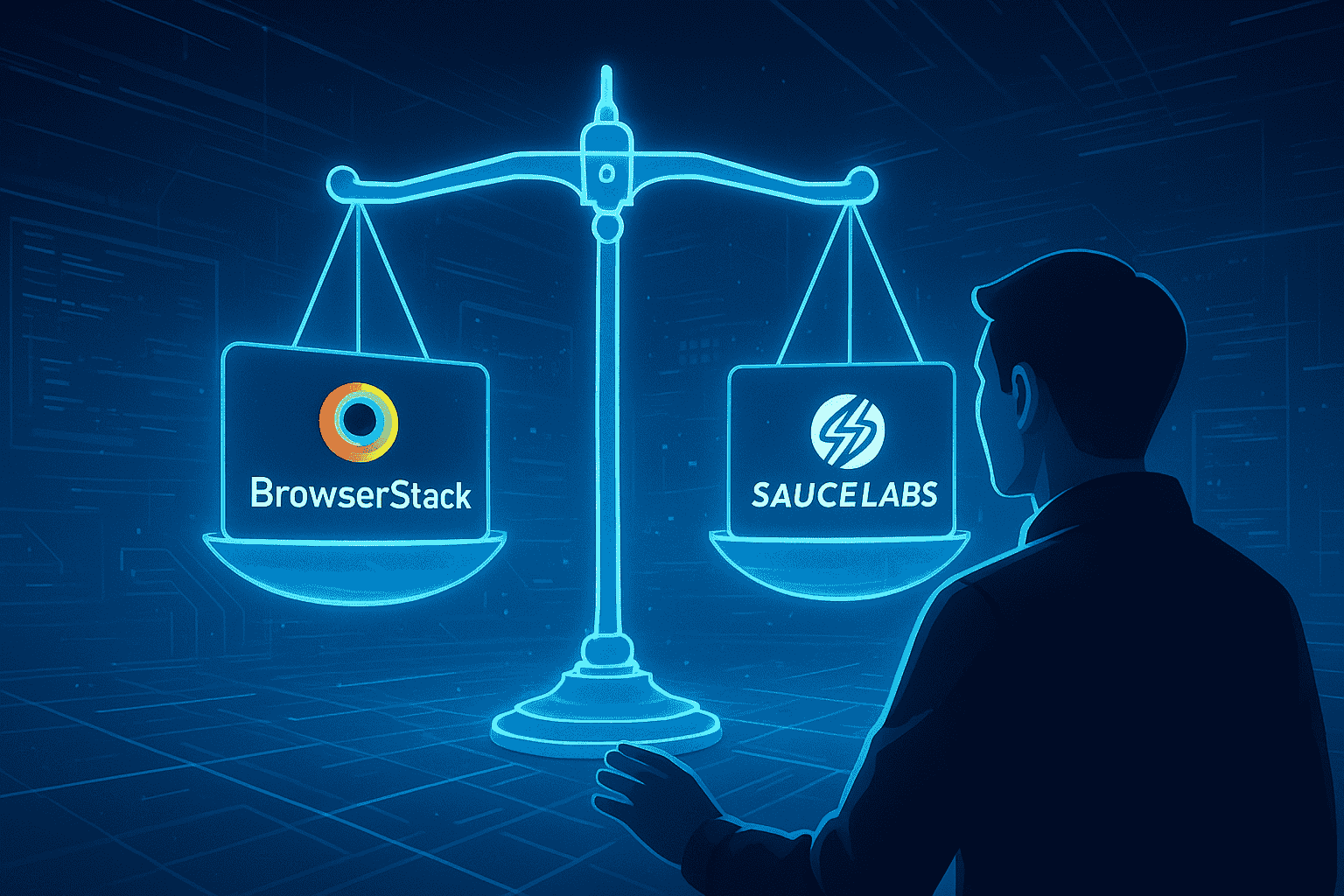BrowserStack and Sauce Labs are two leading cloud-based platforms for automated and manual testing of web and mobile applications. Both offer extensive device and browser coverage, aiming to improve the software quality assurance process with reliable, scalable solutions.
Choosing between them depends largely on specific team needs, such as integration capabilities, test speed, and security requirements.
BrowserStack excels in providing a broad range of real devices for testing, while Sauce Labs focuses on delivering an AI-powered continuous quality platform that supports enterprise-level performance and security.
Understanding the strengths and limitations of each platform helps organizations align their testing strategy with their development goals. Comparing pricing, supported platforms, and user experience can guide teams toward the right tool for their unique requirements.
Key Features Comparison: BrowserStack vs. Sauce Labs

BrowserStack and Sauce Labs are two leading cloud-based testing platforms. Both provide significant support for automated and manual testing with wide device and browser coverage. Their company origins, specific product features, and supported platforms highlight distinct strengths suitable for different testing needs.
Company Backgrounds
BrowserStack was founded in 2011 and quickly established itself as a pioneer in cross-browser testing. It focuses on providing reliable real device cloud testing and emphasizes ease of use for developers and QA teams.
Sauce Labs, launched earlier in 2008, also focuses on automated testing but with a broader emphasis on continuous integration and delivery workflows. It offers tools designed to integrate deeply with DevOps pipelines.
Both companies maintain strong user communities and have scaled their offerings to support enterprises and startups alike. BrowserStack has a larger market share and user recommendation rate, while Sauce Labs is known for strong integration capabilities.
Both platforms emphasize testing efficiency and broad environment coverage but approach their features with different strengths. They cater to automated and traditional testing needs, offer extensive browser support, and provide options for running multiple tests concurrently.
Automated Testing Capabilities
BrowserStack supports a wide range of testing frameworks including Selenium, Cypress, and Playwright. It offers real device cloud testing, which enables tests on actual devices rather than emulators, improving accuracy in results. The platform provides features such as smart waits and detailed test logs to help diagnose failures quickly.
Sauce Labs also integrates with many popular frameworks and adds AI-driven QA test analytics for faster error detection. It supports cloud-based virtual devices and real devices, though real device availability can differ based on region and plan. Sauce Labs emphasizes stable, scalable test execution with features like dynamic test scheduling.
Both platforms support CI/CD pipeline integration, enabling automated testing workflows within development cycles. The choice often depends on specific framework preferences and regional device access requirements.
Manual Testing Tools
BrowserStack offers a live interactive testing environment, allowing testers to run manual tests on more than 3,000 real desktop and mobile browsers. Its interface prioritizes ease of navigation and quick device switching. Features such as screenshot capture, video recording, and network throttling assist in detailed manual testing.
Sauce Labs also provides live testing on real devices with detailed session management. It focuses on collaboration, enabling teams to share live test sessions and debugging information. Its traditional debugging tools include video recordings and console logs, enhancing issue reproducibility.
Both platforms provide essential manual testing support but differ slightly in user interface design and collaboration features, which might influence team productivity during exploratory testing.
Cross-Browser Compatibility
| Platform | BrowserStack | Sauce Labs |
|---|---|---|
| Real Mobile Devices | Yes (wide selection) | Yes (limited compared to BS) |
| Desktop Browsers | Chrome, Firefox, Safari, Edge | Same as BrowserStack |
| Emulators/Simulators | No (focus on real devices) | Yes |
| CI/CD Integration | Supported via API and plugins | Deep CI/CD integration options |
BrowserStack supports over 3,000 browser and OS combinations, including the latest versions of Chrome, Firefox, Safari, Edge, and Internet Explorer. It ensures timely updates to new browser releases and maintains legacy browser support critical for enterprise environments.
Sauce Labs covers a similar range of browsers and operating systems, with consistent updates for upcoming releases. It offers built-in browser versioning controls, allowing users to test against specific browser builds. Sauce Labs also places emphasis on mobile browser compatibility across iOS Safari and Android Chrome.
For teams targeting diverse user bases, both platforms are extremely extensive browser testing tools, with coverage and reliability. BrowserStack may have a slight edge in device variety, while Sauce Labs focuses on version control precision.
Parallel Testing Options
BrowserStack enables parallel QA automation across multiple devices and browsers, reducing overall test time. It supports scaling test concurrency based on subscription plans and offers detailed reports on parallel test outcomes.
Sauce Labs provides robust parallel testing capabilities with an emphasis on scalability. Its cloud infrastructure allows hundreds of parallel tests, with dynamic resource allocation to optimize execution. Users can monitor real-time test status and receive centralized reports.
Both platforms enhance testing speed significantly through parallelization. The decision between them may depend on the scale of concurrency required and cost-effectiveness aligned with team workload.
Integrations and Ecosystem
BrowserStack and Sauce Labs both offer extensive integration capabilities that help streamline testing within development workflows. Their ecosystems support automation, flexible framework compatibility, and connections to widely used third-party tools. These factors play a key role in how effectively each platform fits into a team’s toolchain.
CI/CD Support
BrowserStack integrates smoothly with popular CI/CD platforms like Jenkins, GitHub Actions, and Bitbucket. The setup is straightforward, enabling teams to quickly incorporate automated tests into their pipelines. This ease of use reduces time-to-test and accelerates delivery cycles.
Sauce Labs also supports major CI/CD tools, focusing heavily on scalability for enterprise environments. It provides robust APIs and plugin libraries that accommodate complex continuous testing scenarios. These features make Sauce Labs particularly useful for large teams with advanced automation demands.
Both platforms support parallel test execution and real device cloud access, enhancing their CI/CD integration capabilities.
Framework Integrations
BrowserStack offers broad support for various testing frameworks such as Selenium, Appium, Cypress, and Playwright. It emphasizes compatibility with the latest versions, ensuring users can leverage modern QA tools without restrictions. This makes it highly adaptable for diverse testing needs.
Sauce Labs also supports these frameworks but places more emphasis on automation scalability and pipeline customization. It is preferred by teams that require deep integration into DevOps workflows and advanced test orchestration.
In summary, BrowserStack leans toward broader framework compatibility, while Sauce Labs targets comprehensive automation and scaling options.
Third-Party Tools
Both BrowserStack and Sauce Labs connect with a variety of third-party tools to enhance test management and reporting. BrowserStack supports integrations with test management systems like Jira, TestRail, and Slack for real-time notifications. It also offers plugins for popular IDEs and version control platforms.
Sauce Labs extends this ecosystem to include enterprise-grade monitoring and analytics tools. It integrates with services such as Splunk and New Relic, which help teams analyze test bugs and outcomes alongside application performance data.
The choice often depends on whether the team prioritizes straightforward communication and issue tracking or advanced enterprise monitoring and analytics.
Test Automation Infrastructure
The infrastructure supporting test automation determines the efficiency and reliability of executing automated tests. Key factors include the ability to handle growing workloads, access to a wide range of real devices, and tools for managing test sessions effectively.
Scalability
Both BrowserStack and Sauce Labs offer scalable cloud infrastructures that support large volumes of parallel test executions. Sauce Labs emphasizes a unified platform that integrates continuous testing across the software development lifecycle, allowing teams to scale test runs without performance degradation.
BrowserStack provides a cloud-based Selenium Grid with flexible concurrency options. Users can increase or decrease parallel sessions based on project demands, enabling quicker test cycles during peak times. The scalability in both platforms supports various frameworks and test types, from functional to performance tests.
Real Device Access
Real device testing is critical to ensure app and website compatibility across different hardware and software environments. BrowserStack offers extensive real device access, with hundreds of device models and OS versions available on demand.
Sauce Labs also provides wide real device support but leans towards combining this with virtual environments for maximum coverage. Both platforms eliminate the need to maintain physical device labs, reducing overhead and speeding up testing cycles.
Test Session Management
Effective test session management helps developers tracking, debugging, and optimizing automated tests. BrowserStack offers detailed test logs, video recordings, and screenshots for each session, enabling easier identification of issues.
Sauce Labs complements these features with AI-driven metrics to provide insights into test failures and their root causes. Both systems facilitate integration with CI/CD pipelines, ensuring automated tests can run continuously with comprehensive session reporting.
User Experience and Interface
BrowserStack and Sauce Labs each provide distinct user experiences, focusing on simplicity and efficiency. The ease of starting, navigating the dashboard, and resolving issues shapes how teams interact with the platforms daily. Efficiency in these areas impacts overall productivity and user satisfaction.
Onboarding Process
BrowserStack has a streamlined onboarding process focused on guiding new users through initial setup quickly. It offers clear tutorials and extensive documentation that help users configure testing environments with minimal friction. The platform supports single sign-on (SSO) and various integrations that simplify team adoption.
Sauce Labs also emphasizes a smooth start, with onboarding designed to accommodate both manual and automated testers. It provides step-by-step instructions and sample projects to accelerate learning. However, its installation can be more complex for teams using advanced automation features, sometimes requiring additional time to optimize.
Dashboard Usability
BrowserStack features a clean, intuitive dashboard that organizes devices and browsers by categories, speeding up test selection. The interface uses clear labeling and real-time session information, which reduces the time spent managing active tests. Customizable views allow users to prioritize frequently used configurations.
Sauce Labs offers a dashboard with more detailed analytics and test results, catering well to user needs for in-depth insights. It provides filtering options and historical data access but has a denser interface that may require users to familiarize themselves before maximizing efficiency. This design supports teams focusing on test performance and debugging.
Troubleshooting Tools
BrowserStack includes essential debugging features such as live screenshots, detailed logs, and video recordings of testing sessions. These tools aid in quickly pinpointing errors or UI inconsistencies across browsers and devices. Console logs and network data are also accessible during or after tests.
Sauce Labs enhances troubleshooting with advanced analytics, allowing users to analyze test failures with detailed error breakdowns. It supports parallel debugging with session sharing, enabling team collaboration. The platform’s tooling integrates with CI/CD pipelines, making automated issue tracking more robust.
Which Platform Should You Choose: BrowserStack vs. Sauce Labs?

Choosing between BrowserStack and Sauce Labs isn’t about flashy dashboards. It comes down to your team’s size, testing complexity, and what matters most.
Choose BrowserStack If:

Your team prioritizes speed and simplicity. You want to test on real devices without heavy setup. You’re a small to mid-size team without complex compliance requirements. You care about developer experience and quick feedback loops. Your testing needs are primarily web and automated mobile testing. You want an intuitive interface that doesn’t require training. You’re budget-conscious and want straightforward pricing.
Choose Sauce Labs If:

You’re managing large, enterprise-scale test suites. Your team needs enterprise compliance, SSO, and private cloud options. You require detailed analytics and deep visibility into every test run. You need to run hundreds of parallel tests simultaneously. Your organization uses layered DevOps pipelines with complex workflows. You want AI-powered insights to improve your testing strategy.
The Practical Reality
Both BrowserStack and Sauce Labs deliver dependable, on-premise cloud-based testing infrastructure. The difference lies in their focus: BrowserStack prioritizes simplicity and speed, while Sauce Labs emphasizes scale and depth.
BrowserStack excels at providing an accessible, developer-friendly environment that minimizes setup time. Sauce Labs, on the other hand, offers a robust, data-rich ecosystem designed for enterprises that demand visibility and governance across complex workflows.
The best option depends less on technical superiority and more on alignment with your team’s operational needs and testing philosophy.
Looking Beyond: AI-Driven Mobile Testing Evolution

Here’s something worth considering as you evaluate your testing infrastructure: the industry is quietly shifting toward AI-native testing platforms that combine device coverage with intelligent software automation. Rather than choosing between manual execution on real devices (BrowserStack’s strength) and orchestration complexity (Sauce Labs’ approach), some teams are exploring platforms that unify both.
Platforms like Panto AI represent this evolution. They handle mobile app testing across real devices and emulators while intelligently generating test cases from natural language descriptions. Instead of manually scripting tests or dealing with flaky locators, these next-gen tools use self-healing automation that adapts when your UI changes, eliminating the constant maintenance burden both BrowserStack and Sauce Labs users face.
They also bridge code review, security scanning, and QA automation into one workflow, reducing silos and tool sprawl. It’s not about replacing device clouds; it’s about making the testing layer smarter, faster, and less manual-intensive than traditional frameworks require.
If you find yourself maintaining hundreds of test scripts or constantly updating locators, that might be a signal that your testing philosophy is due for an upgrade — not just a tool swap.
BrowserStack vs. Sauce Labs: Final Thoughts
BrowserStack excels at giving you fast, reliable testing with minimal friction. If your team is small to mid-size and you want to test quickly on real devices, it’s an excellent choice.
Sauce Labs is the enterprise-grade option. It’s built for scale, secure code, and deep visibility. If you’re managing QA at scale or living under strict security policies, Sauce Labs is designed exactly for that.
Panto AI directly addresses a different class of problems by eliminating much of the scripting and maintenance burden altogether through AI-driven, intent-based automation, making it a strong option for teams prioritizing speed, resilience, and scale.
The key is picking the one that matches your current reality: your team’s size, your complexity level, your compliance needs, and your testing philosophy.






